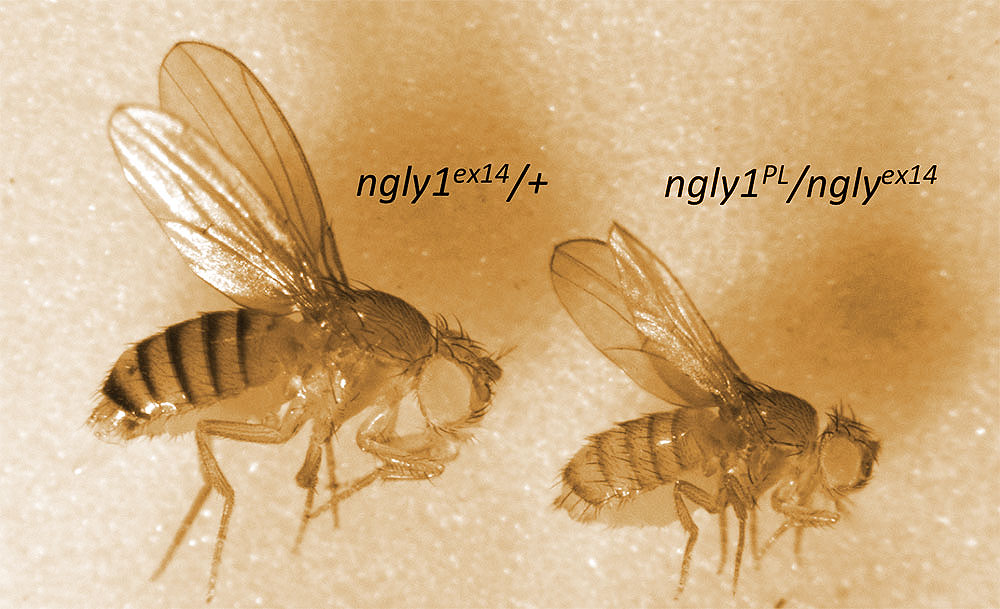Earlier this week I was alerted on Twitter (where else?) to a new NGLY1 paper from Dr. Clement Chow’s lab at the University of Utah titled: “Transcriptome and functional analysis in a Drosophila model of NGLY1 deficiency provides insight into therapeutic approaches,” and hereafter Owings et al. I read Owings et al right away and, of course, compared their results to the results in our recent preprint describing a new fly model of NGLY1 Deficiency, which was posted on bioRxiv earlier this month, and is now a submitted manuscript under review at an open access journal. What follows is my comparison of the two sets of findings. Overall, I’m encouraged by the similarity of our two genetically distinct but complementary fly models of NGLY1/Pngl deficiency. Pngl is the fly ortholog of NGLY1.
Fly model of NGLY1 Deficiency: comparative studies
At Perlara, we developed and characterized a Pngl-/- homozygous loss-of-function (LOF) mutant, which we call ngly1PL. This LOF allele phenocopies genetic null mutants originally created by Tadashi Suzuki and colleagues, exhibits global developmental delay and semi-lethality with a fraction of embryos completing development to adulthood.

The Chow Lab developed and characterized a systemic RNAi knockdown of Pngl using a tubulin-GAL4 ubiquitous driver in a genetically Pngl+/+ background. They refer to Pngl in their paper as dNGLY1. They observed greater than 95% knockdown (6-fold reduction) of dNGLY1 mRNA transcripts in knockdown animals compared to the control strain. As a result they observed severe global developmental delay and lethality at each stage of development.


Above figures from Owings et al
Notable consistencies between two types of disease model
Any residual NGLY1 activity in select cells or tissues or under specific conditions will confound comparisons between a RNAi knockdown model and a homozygous mutation model. Even so, there are notable consistencies between the two types of disease model.
As it stands today, both studies point strongly to NRF1 but from different angles. Owings et al performed unbiased gene set enrichment analysis of dNGLY1 knockdown whole animals compared to the control strain in order to identify cellular pathways that are significantly turned up/on or down/off. Turns out they report in their paper that “genes encoding proteasome subunits and proteins involved in oxidation-reduction functions” go down in expression. Those two gene sets are the major pathways regulated by the fly ortholog of NRF1 called cap n’collar (cnc).

Supplemental Table 3 from Owings et al
In our preprint, we argue that the global developmental delay and other defects we observed in our ngly1PL mutant can also be explained by loss of N-glycanase activity leading to a secondary loss of cnc function in neuroendocrine tissues/organs, specifically loss of the protein isoform containing an extra N-terminal transmembrane domain called cnc-isoform C (cncC).
Owings et al showed that a heat shock during larval development provides partial rescue of lethality, and further showed that loss of heat shock proteins like HSP70 enhances lethality. Consistent with a protective effect of higher temperature but with evidence from further down the thermometer, we showed that pupal lethality is cold-sensitive. Raising the temperature increases adult survivorship to a point.

Model comparison yields greater understanding
Although they didn’t test it in their paper, we predict that dNGLY1 systemic RNAi knockdown strains will be hypersensitive to DMSO and to bortezomib, as are the original Pngl excision allele null mutants generated by Tadashi Suzuki’s lab and our ngly1PL mutant.
Although we didn’t include these data in our preprint, based on discussions with Clement and Matt Might we tested GlcNAc and a proton pump inhibitor for rescue of global developmental delay and semi-lethality of the ngly1PL mutant. Those experiments performed in vials and under our rearing conditions showed no statistical differences between treatments and vehicle. We’ll now attempt to replicate the specific GlcNAc rescue conditions described in Owings et al.
There are three published studies and one preprint describing fly models of NGLY1 Deficiency, ranging in severity from gene deletion to nonsense mutation to ubiquitous RNAi knockdown. Understanding the differences between those models, as well as the effects of environmental modifiers such as temperature, circadian cycles and diet, is the next step toward extracting maximal translational value from fly models of NGLY1 Deficiency.


